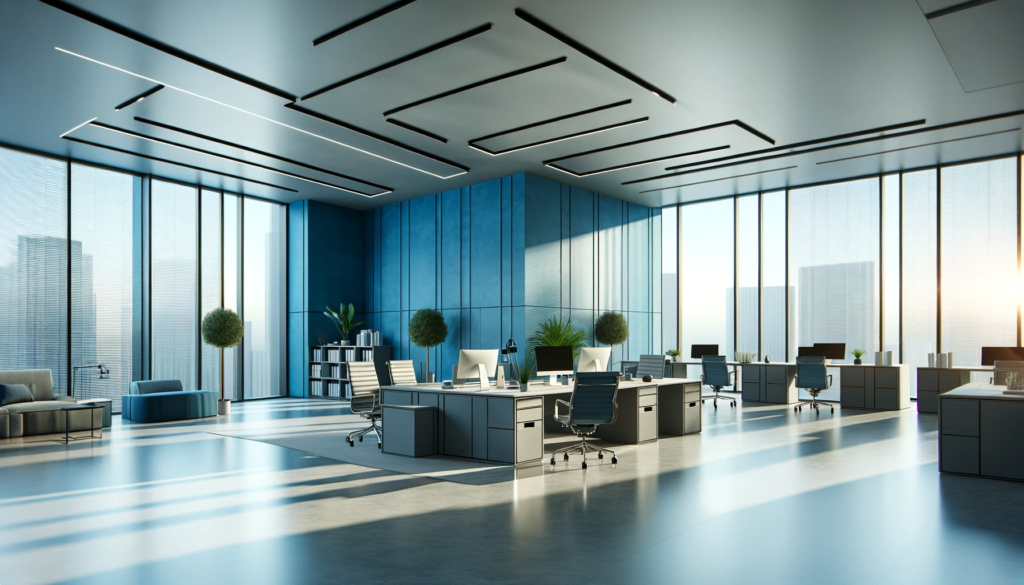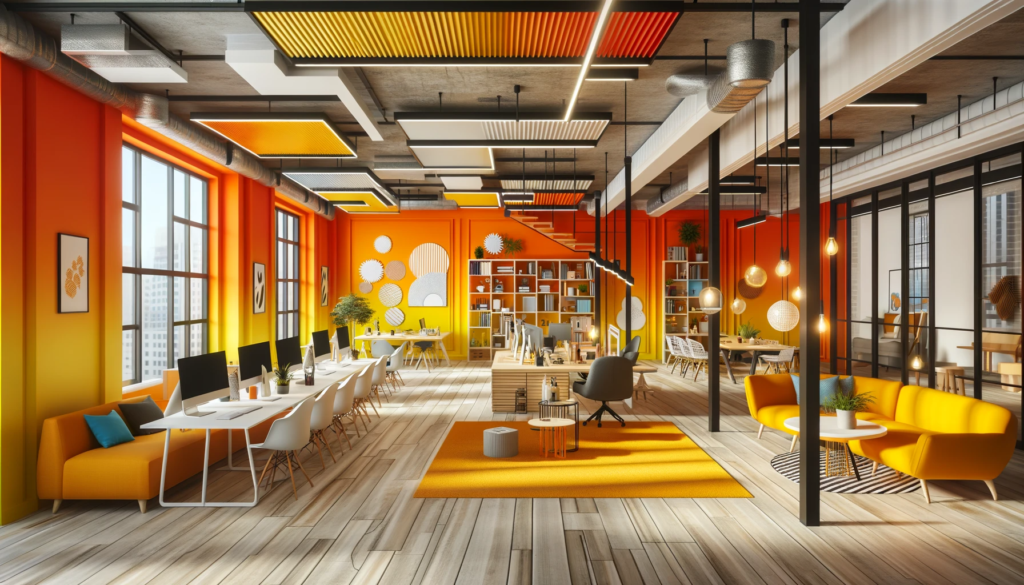In today’s fast-paced business world, the aesthetic appeal of a commercial space plays a crucial role in shaping the impressions and experiences of both employees and clients. This comprehensive guide explores how the strategic use of color, professional expertise, and innovative trends in interior painting can significantly enhance the ambiance and functionality of business environments.
From understanding the psychological impact of color choices to planning a painting project that aligns with your brand’s ethos, the article offers insights into every aspect of commercial interior painting. It emphasizes the importance of professional execution, maintenance practices, and budget considerations, ensuring that readers are well-equipped to make informed decisions for their commercial painting ventures.
As we journey through the nuances of creating visually appealing and lasting impressions through paint, this guide serves as a valuable resource for businesses aiming to rejuvenate their spaces and strengthen their brand identity.

Understanding the Impact of Color in Commercial Spaces
The influence of color in commercial spaces extends far beyond mere aesthetics; it is a powerful tool that can significantly impact mood, productivity, and customer perception. Research in color psychology suggests that different hues evoke distinct emotional responses.
For instance, blue is often associated with professionalism and trust, making it a preferred choice for corporate offices. In contrast, vibrant colors like orange or yellow can stimulate creativity and energy, ideal for dynamic environments such as advertising agencies or creative studios.
Retail spaces frequently utilize reds and oranges, known for their ability to attract attention and encourage impulse buying. Restaurants might opt for warmer, appetizing colors like red or earthy tones to create a cozy, inviting atmosphere. It’s not just about choosing a color that looks good; it’s about selecting a palette that aligns with the business’s brand identity, enhances the desired mood of the space, and positively influences the behavior of employees and clients.
By strategically using color, businesses can create environments that not only reflect their brand’s ethos but also foster a productive and welcoming atmosphere for everyone who steps through their doors.
Planning Your Commercial Painting Project
Embarking on a commercial painting project requires thoughtful planning to ensure the final outcome aligns with your business objectives and aesthetic vision. The first step is choosing the right color palette, which should not only resonate with your brand identity but also complement the architectural elements and lighting of your space. Consider the nature of your business and how different areas are utilized; for example, a lively color might energize a common area, while a calming hue could be more suitable for a conference room.
The selection of paint types and finishes is equally crucial. High-traffic areas demand durable, easy-to-clean paints, whereas matte finishes might be ideal for spaces where minimizing glare is important. It’s also essential to account for the environmental conditions of your space, as factors like humidity and natural light can influence the appearance and longevity of the paint. Involving a professional from the outset can provide invaluable guidance in these decisions.
They can help in assessing the condition of the walls, advising on the best types of paint and finishes for your specific needs, and ensuring a high-quality application. A well-planned commercial painting project not only revitalizes the look of your business but also contributes to a more engaging and productive environment for both employees and customers.
The Role of Professional Painters in Commercial Projects
The involvement of professional painters is pivotal in transforming commercial spaces through interior painting. Their expertise extends far beyond mere application of paint; it encompasses a thorough understanding of surface preparation, paint selection, and application techniques that ensure longevity and aesthetic appeal. Professional painters bring a level of precision and efficiency that is hard to achieve with DIY efforts.
They are adept at handling the logistical challenges of commercial projects, such as working around business hours to minimize disruption and ensuring compliance with safety standards. Moreover, professionals are well-versed in the latest painting trends and technologies, allowing them to offer advice on innovative colors and finishes that could elevate your space. Their experience in dealing with a range of materials and surfaces ensures that every inch of your commercial interior is painted with attention to detail, from high-traffic hallways to intricate trim work.
Importantly, hiring professionals provides peace of mind through warranties and guarantees on their work, ensuring that your investment is protected. In essence, professional painters play an essential role in ensuring that your commercial painting project not only meets but exceeds your expectations, adding value and vibrancy to your business environment.

Trends and Innovations in Commercial Interior Painting
The realm of commercial interior painting is continuously evolving, with new trends and innovations that redefine the aesthetics of business environments. One of the prominent trends is the use of eco-friendly paints, which cater to growing environmental consciousness and offer healthier choices for indoor air quality.
These paints are low in volatile organic compounds (VOCs) and are ideal for businesses aiming to create a more sustainable and employee-friendly workspace. Textured finishes are also gaining popularity, allowing businesses to add depth and character to their walls beyond traditional flat colors. Techniques like faux finishes, metallic paints, and even magnetic or chalkboard paints are being creatively used to make spaces more interactive and visually appealing.
Another innovation in this field is the use of digital color-matching technology, which enables businesses to perfectly match their brand colors, ensuring consistency and brand integrity across all physical spaces. Additionally, there’s a shift towards bold and unconventional color combinations, challenging the traditional norms of commercial decor. This trend reflects a desire to make business spaces more dynamic and aligned with a company’s unique identity. These trends and innovations open up new possibilities for businesses to express their brand story and create engaging environments that resonate with employees and customers alike.
Maintenance and Longevity of Interior Paint in Commercial Settings
Maintaining the aesthetic appeal and durability of interior paint in commercial settings is crucial for preserving a professional and welcoming environment. The longevity of the paint largely depends on the quality of the products used and the precision of the application, which is why hiring professional painters is often advantageous.
Regular maintenance is key to prolonging the life of the paint. This includes routine cleaning of walls to remove dust and dirt, which can otherwise lead to dullness and discoloration over time. In high-traffic areas or spaces prone to wear and tear, such as lobbies or corridors, choosing high-grade, washable paints can be a strategic decision. These paints allow for easy cleaning without damaging the finish.
Additionally, it’s important to promptly address any issues like chips, cracks, or peeling, as these small problems can quickly escalate and compromise the overall look. Businesses should also consider the environmental factors affecting their space, such as exposure to sunlight or moisture, and choose paint types accordingly to prevent fading or mold growth. A periodic professional assessment can help in identifying areas that need touch-ups or a fresh coat, ensuring the paint remains vibrant and effective in reflecting the business’s image. By prioritizing maintenance and using quality materials, businesses can ensure their interior paint remains as impactful and inviting as the day it was first applied.
Budgeting and Cost Considerations
Budgeting effectively for a commercial interior painting project is a critical aspect that requires careful consideration to balance quality with cost-effectiveness. The cost of commercial painting can vary widely based on factors such as the size of the space, the type of paint and finishes chosen, the complexity of the project, and the geographical location. To create an accurate budget, it’s essential to obtain detailed quotes from several professional painting contractors.
These quotes should provide a breakdown of costs including labor, materials, surface preparation, and any additional features like specialized finishes or custom colors. It’s also important to factor in indirect costs such as potential downtime or business disruptions during the painting process. While it may be tempting to choose the lowest bid, investing in high-quality paints and experienced professionals can lead to better long-term value, as these often require fewer touch-ups and last longer.
Additionally, some contractors offer payment plans or phased approaches to the project, allowing for financial flexibility. Businesses should also consider the potential return on investment that a well-executed painting project can bring, such as improved customer perception and increased employee satisfaction, which can indirectly contribute to revenue growth. By carefully planning and allocating resources, businesses can ensure their commercial painting project enhances their space without exceeding their financial limits.
Conclusion
The strategic application of commercial interior painting stands as a vital component in defining and enhancing the aesthetic and functional qualities of business environments. This article has underscored the multifaceted impact of color choices, the importance of meticulous planning, and the invaluable role of professional painters in achieving desired outcomes. We’ve also navigated through the latest trends and innovations in the painting industry, highlighting the shift towards eco-friendly options and creative finishes that add uniqueness to business spaces.
Furthermore, the emphasis on maintenance and cost considerations underscores the long-term value and sustainability of well-executed painting projects. Ultimately, a thoughtfully painted commercial interior does more than just embellish a space; it creates a vibrant and conducive atmosphere for productivity, reflects the business’s brand identity, and resonates with customers and employees alike. As businesses continue to evolve and seek new ways to stand out, commercial interior painting remains a key element in crafting an environment that is not only visually appealing but also a true representation of the brand’s ethos and vision.